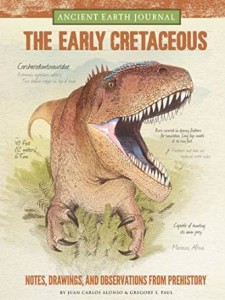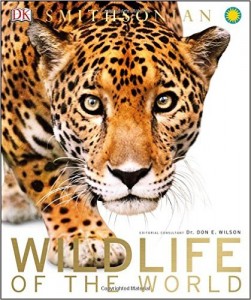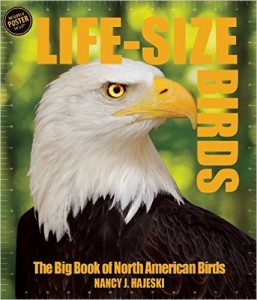2018 School Spending Survey Report
Creature Features | Starring the Best of the New Animal Compendiums
Look into the formidable eyes of an Eastern Hog-Nosed Snake, stare down the toothy jaws of a crocodile, spy some razor-clawed flying prehistoric bipeds, and take a peek at the more than 130 cat breeds in these compendiums of animals past and present.
 Which animals are show-offs, tend to be homebodies, or are unlucky? Groupings with appealing titles sort out the world’s creatures in Adrienne Barman’s, Creaturepedia: Welcome to the Greatest Show on Earth (Wide Eyed Editions, 2015; K-Gr 4). More fun than fact-filled, Barman’s cartoon-style animals appear in chapters distinguished by color, similar physical features, or behavior (for example, readers will find swordfish, the red fox, and the bald eagle in “munch-it-uppers”). The roadrunner, cheetah, and rhinoceros may belong to “sprinters,” but Barman’s sense of humor shines as she portrays them as clouds of dust running off the page, leaving behind only their name and average speed. “Night owls” are invisible, but for their white eyes, on a dark blue page, and “masters of camouflage” are thinly outlined–blending in against their protective habitats. Facts are limited to tiny captions, but clustering animals by shared trait is surprisingly informative as well as entertaining. A visual table of contents depicts one animal that typifies each category, and a general index aids in cross-referencing. Youngest readers may not recognize some words, such as lilliputian, or be able to pronounce the scientific names, but the title is a delightful springboard to inquiry and will expand their introduction to the world’s creatures.
Which animals are show-offs, tend to be homebodies, or are unlucky? Groupings with appealing titles sort out the world’s creatures in Adrienne Barman’s, Creaturepedia: Welcome to the Greatest Show on Earth (Wide Eyed Editions, 2015; K-Gr 4). More fun than fact-filled, Barman’s cartoon-style animals appear in chapters distinguished by color, similar physical features, or behavior (for example, readers will find swordfish, the red fox, and the bald eagle in “munch-it-uppers”). The roadrunner, cheetah, and rhinoceros may belong to “sprinters,” but Barman’s sense of humor shines as she portrays them as clouds of dust running off the page, leaving behind only their name and average speed. “Night owls” are invisible, but for their white eyes, on a dark blue page, and “masters of camouflage” are thinly outlined–blending in against their protective habitats. Facts are limited to tiny captions, but clustering animals by shared trait is surprisingly informative as well as entertaining. A visual table of contents depicts one animal that typifies each category, and a general index aids in cross-referencing. Youngest readers may not recognize some words, such as lilliputian, or be able to pronounce the scientific names, but the title is a delightful springboard to inquiry and will expand their introduction to the world’s creatures.  For feline aficionados, The Cat Encyclopedia (DK, 2014; Gr 5 Up) beckons with an eye-popping volume of photographs (shot close enough for readers to count every whisker) and research-friendly information. Beyond the catalog of more than 130 breeds, there is ample coverage of the biology, culture, and care of cats. An interesting history section includes a discussion of the rise of agriculture in the Fertile Crescent when farmers recognized the benefit of rodent control, and Egyptians began to hold the creatures in even higher esteem. Seafarers and colonizers carried the creatures to other lands, and they have since become a staple topic of folklore, art, and entertainment. Scientific diagrams illustrate biology such as digestion, the immune system, and understanding whiskers and coat colors. The bulk of the volume is devoted to the beautiful individual breeds, and up-close photography presents adult and kitten specimens in labeled poses, pointing out head shape, paw size, and other defining characteristics. Schools offering an agriculture program, or small-animal husbandry classes, will value the amount of factual, and easily retrievable, information.
For feline aficionados, The Cat Encyclopedia (DK, 2014; Gr 5 Up) beckons with an eye-popping volume of photographs (shot close enough for readers to count every whisker) and research-friendly information. Beyond the catalog of more than 130 breeds, there is ample coverage of the biology, culture, and care of cats. An interesting history section includes a discussion of the rise of agriculture in the Fertile Crescent when farmers recognized the benefit of rodent control, and Egyptians began to hold the creatures in even higher esteem. Seafarers and colonizers carried the creatures to other lands, and they have since become a staple topic of folklore, art, and entertainment. Scientific diagrams illustrate biology such as digestion, the immune system, and understanding whiskers and coat colors. The bulk of the volume is devoted to the beautiful individual breeds, and up-close photography presents adult and kitten specimens in labeled poses, pointing out head shape, paw size, and other defining characteristics. Schools offering an agriculture program, or small-animal husbandry classes, will value the amount of factual, and easily retrievable, information.  Christina Wilsdon’s Ultimate Reptileopedia (2015; Gr 3-8), boasts stunningly vivid photography characteristic of the National Geographic name. Curious readers can look into the formidable eyes of an Eastern Hog-Nosed Snake, stare down the toothy jaws of a crocodile, and easily examine the scaly physical features of lizards, turtles, and other reptiles. An introduction, “Discovering Reptiles,” answers general questions about these creatures’ features, how they reproduce, regulate temperature, talk, and defend themselves. Profiles of more than 100 reptiles, arranged by order, are described with three meaty paragraphs of text amid the captioned, up-close images. The book is not for the squeamish, although curious kids and reptile enthusiasts will be captivated by such images as a Rock Python devouring a gazelle, or the green Paradise Flying Snake gliding through the air. For researchers, a fact box offers common and scientific names and information on size, food, habitat, and range. An interview with a herpetologist, conservation tips, a glossary, a list of Web resources, and a general index, help this title live up to its "ultimate" epithet.
Christina Wilsdon’s Ultimate Reptileopedia (2015; Gr 3-8), boasts stunningly vivid photography characteristic of the National Geographic name. Curious readers can look into the formidable eyes of an Eastern Hog-Nosed Snake, stare down the toothy jaws of a crocodile, and easily examine the scaly physical features of lizards, turtles, and other reptiles. An introduction, “Discovering Reptiles,” answers general questions about these creatures’ features, how they reproduce, regulate temperature, talk, and defend themselves. Profiles of more than 100 reptiles, arranged by order, are described with three meaty paragraphs of text amid the captioned, up-close images. The book is not for the squeamish, although curious kids and reptile enthusiasts will be captivated by such images as a Rock Python devouring a gazelle, or the green Paradise Flying Snake gliding through the air. For researchers, a fact box offers common and scientific names and information on size, food, habitat, and range. An interview with a herpetologist, conservation tips, a glossary, a list of Web resources, and a general index, help this title live up to its "ultimate" epithet.  Paleoartists Juan Carlos Alonso and Gregory S. Paul breathe life into the magnificent creatures that lived during a period of rapid change, 120 million years ago. Ancient Earth Journal: The Early Cretaceous (Walter Foster, 2015: Gr 2-6), characterizes the rise of flowering plants and the evolution of insects, lizards, snakes, birds, and mammals that would suggest a modern-looking Earth, but for the giant herbivores (five stories tall), and razor-clawed flying bipeds. Chapter divisions for "Theropauds," "Sauropods," "Ornithischians," "Pterosaurs," and "First Birds," contain double-paged entries for colorful sketches of individual dinosaurs in action poses, and close ups of some physical features. Formatted like a personal journal, the tan pages mimic fibrous sketchbook paper, and the notes are in a handwritten-style font. As an example, the Sauroposeidon proteles, once located in Oklahoma, resembles the body shape of a giraffe and is described as one of the tallest animals to walk the planet at nearly 60 feet. A small chart offers an image of relative size, and other captions around the sketch point to the dermal spines to attract mates, and its social but territorial temperament. The value of this title lies in the organic and authentic quality of the beautiful drawings these talented, artist-scientists have helped inform young readers about prehistory.
Paleoartists Juan Carlos Alonso and Gregory S. Paul breathe life into the magnificent creatures that lived during a period of rapid change, 120 million years ago. Ancient Earth Journal: The Early Cretaceous (Walter Foster, 2015: Gr 2-6), characterizes the rise of flowering plants and the evolution of insects, lizards, snakes, birds, and mammals that would suggest a modern-looking Earth, but for the giant herbivores (five stories tall), and razor-clawed flying bipeds. Chapter divisions for "Theropauds," "Sauropods," "Ornithischians," "Pterosaurs," and "First Birds," contain double-paged entries for colorful sketches of individual dinosaurs in action poses, and close ups of some physical features. Formatted like a personal journal, the tan pages mimic fibrous sketchbook paper, and the notes are in a handwritten-style font. As an example, the Sauroposeidon proteles, once located in Oklahoma, resembles the body shape of a giraffe and is described as one of the tallest animals to walk the planet at nearly 60 feet. A small chart offers an image of relative size, and other captions around the sketch point to the dermal spines to attract mates, and its social but territorial temperament. The value of this title lies in the organic and authentic quality of the beautiful drawings these talented, artist-scientists have helped inform young readers about prehistory.  From images of the small stag beetle of Europe to the mammoth blue whale of the Antarctic, editor Don E. Wilson has compiled an oversize showpiece volume in Wildlife of the World (DK Smithsonian, 2015: Gr 7 Up). Arranged by continent, dazzling photography depicts some animals against white backgrounds to allow for closer examination, and others in the context of their environment, for example, bounding across a savanna, perching on a branch, or splashing through a stream. A data panel for each animal uses symbols from a key in the front of the book to designate size, weight, food source, endangered status, location, and other salient points. Ecosystems such as the Bornean Rainforest, Scottish Highlands, Argentine Pampas, Norwegian Fjords, and dozens more, are diagrammed as a wheel, with flora and fauna facts and photos wrapped around a scenic depiction of the habitat. More than just glitz and glamour, the book contains contributions from many Smithsonian wildlife experts who offer readable narrative that tie animal food sources, migration habits, and such, to the environment, and offer brief information about conservation efforts. A separate animal habitat section, “Animal Kingdom” grouping appendix, and index, go a long way to make this a holistic approach to animal inquiry.
From images of the small stag beetle of Europe to the mammoth blue whale of the Antarctic, editor Don E. Wilson has compiled an oversize showpiece volume in Wildlife of the World (DK Smithsonian, 2015: Gr 7 Up). Arranged by continent, dazzling photography depicts some animals against white backgrounds to allow for closer examination, and others in the context of their environment, for example, bounding across a savanna, perching on a branch, or splashing through a stream. A data panel for each animal uses symbols from a key in the front of the book to designate size, weight, food source, endangered status, location, and other salient points. Ecosystems such as the Bornean Rainforest, Scottish Highlands, Argentine Pampas, Norwegian Fjords, and dozens more, are diagrammed as a wheel, with flora and fauna facts and photos wrapped around a scenic depiction of the habitat. More than just glitz and glamour, the book contains contributions from many Smithsonian wildlife experts who offer readable narrative that tie animal food sources, migration habits, and such, to the environment, and offer brief information about conservation efforts. A separate animal habitat section, “Animal Kingdom” grouping appendix, and index, go a long way to make this a holistic approach to animal inquiry.  Marked out in inches, a ruler frames every page to allow readers an accurate image of birds they may never see so close up. Despite its large format, Nancy J. Hajeski’s Life-Size Birds: The Big Book of North American Birds (Thunder Bay, 2015; Gr 8 Up), can only show the heads of large birds, such as Bald Eagle, Sandhill Crane, and Wild Turkey in full size. Each species is shown authentically, in flight, feeding, nesting, or other natural pose, and the photos are labeled to gauge the size, such as 1:1 (full scale) or 1:4 (reduced scale). Approximately 100 selected entries include commonly known species (with scientific name), in a double-paged spread featuring photos, informational text, and a fact file. Grouped by shared traits, bird identification becomes easier when noting common features, such as the powerful bill of the woodpeckers, long legs of the waders, rounded body of the game birds, or wingspan of the predators. Special chapters, color-blocked in purple, appear intermittently and examine nests, eggs, migration, threats to survival, and more. Distribution maps, habitat descriptions, and a few sentences of narrative will aid inquiry projects, while the physical marvel of birds in flight and intricacies of color and feathering, will also attract nature artists and budding ornithologists.
Marked out in inches, a ruler frames every page to allow readers an accurate image of birds they may never see so close up. Despite its large format, Nancy J. Hajeski’s Life-Size Birds: The Big Book of North American Birds (Thunder Bay, 2015; Gr 8 Up), can only show the heads of large birds, such as Bald Eagle, Sandhill Crane, and Wild Turkey in full size. Each species is shown authentically, in flight, feeding, nesting, or other natural pose, and the photos are labeled to gauge the size, such as 1:1 (full scale) or 1:4 (reduced scale). Approximately 100 selected entries include commonly known species (with scientific name), in a double-paged spread featuring photos, informational text, and a fact file. Grouped by shared traits, bird identification becomes easier when noting common features, such as the powerful bill of the woodpeckers, long legs of the waders, rounded body of the game birds, or wingspan of the predators. Special chapters, color-blocked in purple, appear intermittently and examine nests, eggs, migration, threats to survival, and more. Distribution maps, habitat descriptions, and a few sentences of narrative will aid inquiry projects, while the physical marvel of birds in flight and intricacies of color and feathering, will also attract nature artists and budding ornithologists.  Prickly pufferfish, harpoon snouted cone snails, and starfish whose arms grab hold of mussels and injest them alive, are just a few of the 80 ocean denizens described in Derek Harvey’s Super Shark Encyclopedia and Other Creatures of the Deep (DK, 2015; Gr 6 Up). The chapters focus on shared traits and unique survival features needed for a hugely shared space, such as athleticism, super senses, or camouflaged anatomy. Nicknames head up the entries, such as “Shifty Eyes” for the Lefteye Flounder, or “Shellfish Smasher” for the Sea Otter. The names key in on unique characteristics that will engage readers and build lasting background knowledge, for example “Most Devoted Mother,” the Common Octopus, has such a short lifespan that it spends most of its 12-18 months laying eggs and protecting them from predators. A short narrative augments colorful close-ups (such as the tube feet on a Sea Cucumber), “At a Glance” facts, and a “Stats and Facts” infographic for cruising depth, size, gestation period, and the like. Generously labeled cross-section illustrations highlight specialized anatomy of some creatures, such as the Loggerhead Turtle, to show how it can swim long distances. Shark information is plentiful, but readers will be acquainted with equally fascinating sea creatures that are just as athletic, formidable, and yes—magnificent.
Prickly pufferfish, harpoon snouted cone snails, and starfish whose arms grab hold of mussels and injest them alive, are just a few of the 80 ocean denizens described in Derek Harvey’s Super Shark Encyclopedia and Other Creatures of the Deep (DK, 2015; Gr 6 Up). The chapters focus on shared traits and unique survival features needed for a hugely shared space, such as athleticism, super senses, or camouflaged anatomy. Nicknames head up the entries, such as “Shifty Eyes” for the Lefteye Flounder, or “Shellfish Smasher” for the Sea Otter. The names key in on unique characteristics that will engage readers and build lasting background knowledge, for example “Most Devoted Mother,” the Common Octopus, has such a short lifespan that it spends most of its 12-18 months laying eggs and protecting them from predators. A short narrative augments colorful close-ups (such as the tube feet on a Sea Cucumber), “At a Glance” facts, and a “Stats and Facts” infographic for cruising depth, size, gestation period, and the like. Generously labeled cross-section illustrations highlight specialized anatomy of some creatures, such as the Loggerhead Turtle, to show how it can swim long distances. Shark information is plentiful, but readers will be acquainted with equally fascinating sea creatures that are just as athletic, formidable, and yes—magnificent. RELATED
BOOKS
PREMIUM
Tide’s Journey
BOOKS
PREMIUM
The Smushkins: ABC Zoinks
BOOKS
PREMIUM
Whose Footprint Is That?
BOOKS
PREMIUM
Our World: Vietnam
RECOMMENDED
CAREERS
The job outlook in 2030: Librarians will be in demand
CAREERS
The job outlook in 2030: Librarians will be in demand
ALREADY A SUBSCRIBER? LOG IN
We are currently offering this content for free. Sign up now to activate your personal profile, where you can save articles for future viewing






Add Comment :-
Be the first reader to comment.
Comment Policy:
Comment should not be empty !!!